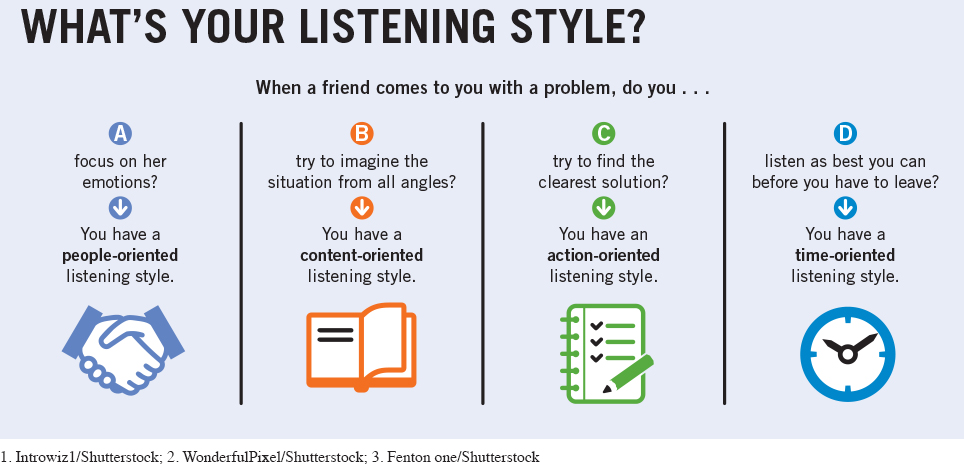Four Listening Styles
Like the characters in Milne’s beloved tales, we all tend to listen in the same way, regardless of the situation. A habitual pattern of listening behaviors, which reflects your attitudes, beliefs, and predispositions about listening, is known as a listening style (Barker & Watson, 2000). In general, there are four different listening styles.
People-oriented listeners view listening as an opportunity to establish bonds between themselves and others. When asked to identify the single most important aspect of competent listening, people-oriented listeners say that it’s empathy for other people’s emotions (Barker & Watson, 2000). Because of their ability to empathize, others perceive them as being caring and concerned.
Content-oriented listeners prefer to be intellectually challenged by the messages they receive. They thoroughly evaluate what’s been said before they draw conclusions, and they enjoy hearing all sides of an argument.
Action-oriented listeners (or task-oriented listeners) like focused and organized information, and they want clear, to-the-point messages from others. They use that information to quickly make decisions and plot courses of action.
Time-oriented listeners prefer brief encounters. They tend to let others know in advance exactly how much time they have available for each conversation. Individuals using this style are more likely to interrupt speakers and signal lack of interest through negative feedback than people using other styles (Barker & Watson, 2000).
Listening styles are learned early in life, from watching and interacting with parents and caregivers, gender socialization (learning about how men and women are “supposed” to listen), and cultural values regarding what counts as skilled listening (Barker & Watson, 2000). Through constant practice, your listening styles become deeply entrenched in your communication routines. As a consequence, you may rely on one or two styles for all your interactions, and resist switching from your dominant styles—even when those styles are inappropriate for the situation (Chesebro, 1999). This may result in people perceiving you as an inflexible and even incompetent communicator. To be an active listener, you have to use all four styles and strategically deploy them as needed. If you need to provide emotional support—perhaps a friend is going through a breakup—you should use a people-oriented listening style (Barker & Watson, 2000). But if you are listening to a professor present lecture recaps for a midterm, you would want to use an action-oriented style to quickly pick out the information you will need to study.
Page 177
Figure 7.1: FIGURE 7.1 WHAT’S YOUR LISTENING STYLE?

1. Introwiz1/Shutterstock; 2. WonderfulPixel/Shutterstock; 3. Fenton one/Shutterstock
